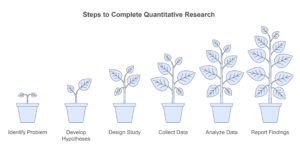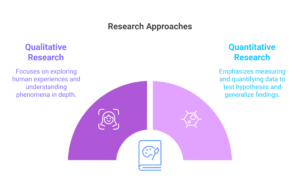 Qualitative vs. Quantitative Research: Choosing the Right Approach
Qualitative vs. Quantitative Research: Choosing the Right Approach
Qualitative Research: An In-Depth Exploration
What is Qualitative Research?
Qualitative research is an investigative method focused on understanding complex phenomena from a holistic, human perspective. It emphasizes gathering in-depth insights into people’s thoughts, behaviors, motivations, and experiences. Rather than focusing on numbers, qualitative research explores the richness of human experience and aims to provide a comprehensive understanding of an issue or subject.
Key Characteristics of Qualitative Research
- Exploratory Nature: Unlike quantitative research, which seeks to confirm hypotheses, qualitative research is more open-ended. It aims to explore areas where little is known, making it ideal for generating new ideas, theories, or understanding complex social and psychological issues.
- Data Forms: Qualitative research uses non-numerical data, including:
- Interviews: One-on-one conversations with participants to uncover insights into their thoughts, feelings, or experiences.
- Focus Groups: Group discussions that allow for diverse viewpoints on a topic.
- Observations: Directly observing behaviors or events to gain insight into the subject matter.
- Textual Analysis: Analyzing written or visual content to understand underlying meanings or patterns.
- Subjectivity and Context: Researchers interpret data subjectively, meaning their insights are influenced by their own perspectives. While this adds depth, it also introduces potential biases. However, context plays a crucial role in qualitative research, as it helps to understand the underlying reasons behind human behavior in specific settings.
- Flexibility: Qualitative methods are not rigidly structured. Researchers often adjust the process based on emerging findings, allowing the study to evolve as new data surfaces.

Qualitative Research Process Steps
- Define Problem
Start by identifying the core issue or topic to be explored. This step sets the foundation for your research by establishing the purpose and scope. - Develop Questions
Frame open-ended questions that guide the exploration of the subject. These questions often focus on “how” and “why” to uncover deep insights. - Select Participants
Choose individuals or groups who have relevant experiences or perspectives. Sampling is often purposive, focusing on those who can provide rich, detailed information. - Collect Data
Use qualitative methods like interviews, focus groups, or observations to gather non-numerical data. Ensure ethical practices during data collection. - Analyze Data
Examine the collected information for recurring themes, patterns, and insights using techniques like thematic or content analysis. - Interpret Findings
Summarize the data to understand the broader implications and provide answers to the research questions. This step involves explaining the meaning behind the patterns identified.
Applications of Qualitative Research
- Consumer Behavior: Understanding why consumers make particular choices, the factors that influence purchasing decisions, or brand loyalty.
- Cultural Studies: Exploring the values, beliefs, and practices of different cultural groups.
- Social Sciences: Gaining a deep understanding of complex social issues such as poverty, education, or inequality.
Advantages of Qualitative Research
- Rich, In-Depth Insights: Qualitative research offers a deeper understanding of subjects by capturing experiences, emotions, and perceptions.
- Flexibility: The methodology is flexible, allowing the researcher to explore new angles or modify questions based on ongoing findings.
- Holistic View: It provides a comprehensive understanding of an issue, rather than just quantifiable results.
Limitations of Qualitative Research
- Subjectivity: The researcher’s interpretations can introduce biases that affect the results.
- Limited Generalizability: Findings from small sample sizes are difficult to apply to larger populations.
- Time and Resource Intensive: Qualitative research often requires significant time for data collection and analysis, making it resource-heavy.
Quantitative Research: Measuring and Analyzing Numbers
What is Quantitative Research?
Quantitative research is focused on the systematic collection and analysis of numerical data. It aims to quantify problems, behaviors, or phenomena by way of statistical analysis. This method is often used to test hypotheses, look for correlations between variables, and establish patterns or trends that can be generalized to larger populations.
Key Characteristics of Quantitative Research
- Objective and Structured: Quantitative research emphasizes objectivity. It utilizes standardized instruments such as surveys, experiments, and tests, which ensure the reliability and consistency of the data collected.
- Data Collection Methods: The methods in quantitative research are designed to produce numerical data:
- Surveys and Questionnaires: Standardized tools that collect data on opinions, behaviors, or characteristics.
- Experiments: Controlled studies where variables are manipulated to observe their effects.
- Observational Research: Data collection is done systematically, often using predefined measures to track specific behaviors or outcomes.
- Secondary Data: Analyzing existing datasets like government reports, health statistics, or financial records.
- Statistical Analysis: The data collected in quantitative research is analyzed through statistical methods. The goal is to test hypotheses and determine the relationships between variables. Tools such as regression analysis, t-tests, and chi-square tests are used to draw conclusions.
- Generalizability: One of the primary strengths of quantitative research is the ability to generalize findings. Larger sample sizes increase the likelihood that the results can be applied to the broader population.
Steps to Complete Quantitative Research
- Identify Problem
Clearly define the problem or question you aim to address. This step ensures the research has a specific focus and measurable objectives.
- Develop Hypotheses
Formulate testable predictions or relationships between variables. Hypotheses guide the research design and analysis. - Design StudyPlan the research process, including selecting a methodology (e.g., survey, experiment) and defining variables. Ensure the study is structured and replicable.
- Collect Data
Gather numerical data systematically using tools like surveys, experiments, or observational checklists. - Analyze Data
Use statistical techniques to process and interpret the data. This may include descriptive statistics (e.g., averages) or inferential methods (e.g., regression analysis). - Report Findings
Present results using charts, graphs, and written summaries. Highlight key insights, trends, and implications for the research problem.
Applications of Quantitative Research
- Market Research: Collecting numerical data about consumer preferences, purchasing habits, and demographic trends.
- Public Opinion: Using surveys to measure public attitudes toward political issues, social policies, or products.
- Health Research: Conducting clinical trials, measuring treatment outcomes, or analyzing epidemiological data to determine trends in disease prevalence.
Advantages of Quantitative Research
- Objectivity and Precision: Quantitative research is less prone to personal biases because it uses standardized data collection methods and statistical analysis.
- Generalizability: With larger sample sizes, the findings from quantitative research can often be generalized to larger populations.
- Reliability: The structured methods used in quantitative research ensure consistency and replicability across studies.
Limitations of Quantitative Research
- Lack of Depth: While quantitative research excels at measuring the “what,” it often fails to explore the “why” behind behaviors or phenomena.
- Over-simplification: Complex issues may be oversimplified into numeric data, leaving out context or nuances.
- Inflexibility: Once the research design and instruments are set, making adjustments can be difficult or impossible, limiting adaptability.

Choosing the Right Approach: Qualitative vs. Quantitative
When deciding between qualitative and quantitative research, it’s essential to consider the nature of your research question and the type of data you need. Qualitative research is ideal for exploring complex, subjective experiences and gaining in-depth understanding. On the other hand, quantitative research is best suited for testing hypotheses, analyzing relationships between variables, and deriving generalizable conclusions. Ultimately, both approaches can be powerful tools for gathering valuable insights. The choice depends on whether you seek depth and richness or broad, statistical evidence. In many cases, combining both approaches through mixed-methods research can provide the most comprehensive view of a subject.
FAQs
1. What is the main difference between qualitative and quantitative research?
Qualitative research explores subjective experiences and focuses on depth, while quantitative research measures objective data and emphasizes breadth.
2. Can both methods be used together?
Yes, mixed-methods research combines qualitative and quantitative approaches to leverage their respective strengths.
3. How do I choose between qualitative and quantitative research?
Choose qualitative research for exploring new phenomena or understanding complex experiences. Opt for quantitative research to test hypotheses or analyze numerical data.
4. What are examples of qualitative and quantitative research?
- Qualitative: Conducting interviews to explore employee morale.
- Quantitative: Running surveys to measure customer satisfaction rates.
5. What are some limitations of each method?
- Qualitative: Subjectivity and limited generalizability.
- Quantitative: Lack of context and oversimplification of data.
6. How can I ensure reliability in qualitative and quantitative research?
- Qualitative: Use triangulation and maintain transparency in data interpretation.
- Quantitative: Employ standardized tools and conduct replicable studies. if you need more inquiry and help in you thesis work Contact Us you can also visit https://www.nu.edu/blog/qualitative-vs-quantitative-study/#:~:text=While%20both%20share%20the%20primary,how%20different%20people%20experience%20grief.




